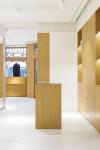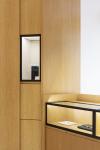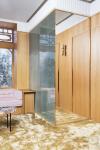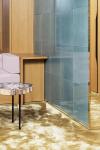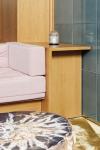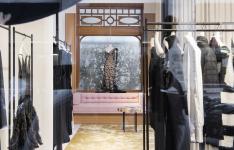FOREWORD
This fall, the Maison John Galliano opened its new luxury boutique located at the intersection of rue des Archives and rue Sainte-Croix de la Bretonnerie, and designed by Franklin Azzi in collaboration with the Atelier Franck Durand.
The project addressed a twofold challenge for the architect: to make the best use of the emblematic urban context of the Marais, and to renew the luxury brand. Franklin Azzi is anything but a beginner, since fashion designers such as Christophe Lemaire, Isabel Marant, Jérôme Dreyfuss, Bali Barret, and Lacoste have already entrusted him with the conception of their stores. But here, the way he revisits the use of noble materials to meet the high standards of fashion luxury, differs from earlier projects.
FACADE DESIGN
A hair salon previously occupied the premises. The existing facade design was far too absent. Franklin Azzi clads it with a black-lacquered wood mantle piece which is inspired in large part by neo-Victorian molding fashions: an idea both in accordance with Galliano’s identity, and in agreement with the requests of ABF (Architectes des Bâtiments de France) authorities. The wooden joints, edges and corners of the facade elements are decorated with moldings. Brass-inlay signs generously adorn the upper frieze and lower window-frames, while the fabric blinds are elegantly embroidered with the brand’s signature. Strongly announcing a traditional London-style architecture, this new store appears as a salient feature within the more typical Haussmann-style buildings of the surroundings, evoking the mystery it preserves precisely because of that contrast.
A BOUTIQUE WITH AN APARTMENT ATMOSPHERE
The boutique was envisioned as an apartment, thus given an intimate atmosphere. Spaces are motley, designed with eclectic influences. According to Franklin Azzi: « This project is very representative of how architects and designers of my generation have to cope with a heritage of hybrid cultures and inspirations. It is like a ‘cadavre exquis’ of insights: the neo-Victorian facade, the sixties-style interiors with carpeted floors and vintage chairs, Gio Ponti’s accordion wall direct citation, contemporary poured concrete floor, and pastiche classical plaster cornices... »
RICHNESS OF MATERIALS AND SHADES
Notwithstanding this imbrication of periods and styles, this project is also characterized by the richness and abundance of the materials used.
The interior ‘shell’ is treated with a minimalism touch, adopting a color-chart of smooth whites and vibrant tones of grey that are to be found in: the wall coating, the concrete floors, the plaster cornices and the linen cloth of the sliding partition walls. The edges and corners are crimped with brass, an alloy of copper and zinc also to be find in the 1960’s lamps hunted at the Paul Bert flea-market. The bespoke furniture is in stained oak: the choice of plain and bare wood surfaces, simply shaped, enables to assert the sole function of the furniture which is to display the garments and accessories.
The fitting rooms are lined with glimmering carpeting, rose quartz and amber for women, blue gravel for men. Enameled lava stone decorates one of the walls and some shelves, discreetly indicating the celadon green shades space, also present in the leather covering the counter. This richness and handling of materials embodies the extent of the summoned craftsmen’s skills and expertise. For the first time, Franklin Azzi, customarily loyal to minimalism, uses an extended range of colors, tempered with the matter they imbue in a refined way.
DOMESTICATING THE PREMISES’ HISTORY
The existing space needed to be revisited: lack of a decent facade, of brightness, and of proper distribution. During the demolition works, the architect discovers three typically Parisian cast-iron poles which capitals he uncovers, and disposes of existing partitions to provide more light and better visibility. Where a rear window was sealed off, it is reopened and equipped with wired glass, just to let the light through.
The new distribution is clear: accessories, jewelry and leatherwork range at the entrance, and then women’s wear on the left, men’s wear on the right, children’s wear at the center along with the counter. Racks made of thin steel tubes are anchored to the ground, defining the customer’s movements. Great linen cloth sliding partition walls, referring to Gio Ponti’s accordion wall, allows defining the spaces differently when needed, varying under the circumstances. For instance, the evening dresses salon can be totally isolated from both the rest of the boutique and from the view of the passersby, for more intimacy and comfort. These biases seek to provide a domestic setting for the project, symbolizing the renewal of the Maison John Galliano, but also the premises’ history.
Franklin Azzi is once again showing his determination to anchor a part of modernity into cultural heritage. This contrast between the interior and the facade design enables him to update the high standards of luxury. The latter is less to be found in ostentation, but more in the materials richness and conception of the architecture project.
2016
2018
Lead Architect
FRANKLIN AZZI
Team
Execution architects : Franklin Azzi
Artistic management : Franck Durand
Clients
LVMH





